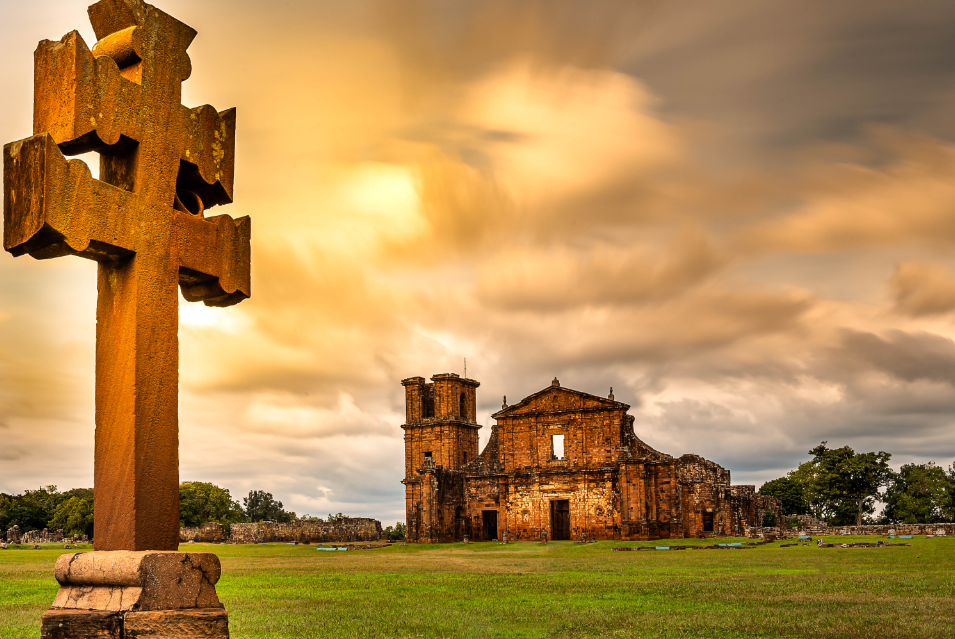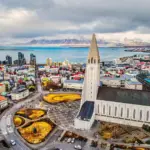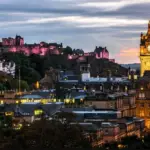
Welcome to our article on the heritage of humanity node Brazil. In this article, we will present the Brazilian sites that have been recognized worldwide as cultural and natural heritage sites of humanity by UNESCO.
THE Brazil is a country rich in cultural and natural diversity, and has the honor of having 23 sites recognized as World Heritage Sites by UNESCO, which is a great source of pride for all Brazilians.
Main Conclusions:
- THE World Heritage Site is a international recognition granted by UNESCO to cultural and natural sites that have unique importance to humanity.
- THE Brazil has 23 locations recognized as World Heritage Site.
- World Heritage Treasures in Brazil include cultural sites such as the historic city of Ouro Preto and Savior, in addition to areas natural areas such as the National Park of Iguaçu and the Pantanal Matogrossense.
- Exploring these places is a unique opportunity to discover the riches cultural and natural of our country.
- Preserving these places is a responsibility for all of us to ensure that future generations can also enjoy these treasures.
What is World Heritage?
World Heritage is a program developed by UNESCO (United Nations Educational, Scientific and Cultural Organization) to protect and preserve sites of great cultural and natural importance around the world.
Sites inscribed on the World Heritage List are internationally recognized as having outstanding universal value and must be protected and preserved for future generations. Selection is based on rigorous criteria that consider the cultural, historical, and scientific importance of the site, as well as its natural beauty and unique ecosystems.
Currently, the list includes more than 1,100 locations worldwide, 23 of which are located in Brazil.

Brazilian Cultural Heritage
Brazil is a country rich in cultural heritage, with traditions and events that are internationally recognized. The country's ethnic and cultural diversity is reflected in its artistic expressions and throughout its history.
One of the events Brazil's most famous cultural event is Carnival, celebrated throughout the country. During Carnival, people gather to dance, sing, and parade in extravagant costumes. Samba schools are one of the main attractions, with elaborate performances that involve music, dance, and history.
Another important cultural tradition is Brazilian cuisine, which varies by region. Typical dishes include feijoada, barbecue, and tapioca, among many other delicious dishes. music and dance are also strongly present in Brazilian culture, with rhythms such as samba, MPB and forró.
Artistic Manifestations
Brazilian art is a blend of local and international influences, with many renowned artists achieving worldwide recognition. architecture colonial of the country is one of the main tourist attractions, with historic buildings and churches dating back to the 16th century. The modernist movement also had a major impact on Brazilian art, with names like Tarsila do Amaral and Oscar Niemeyer.
Recognized Cultural Heritage
UNESCO has recognized many sites in Brazil as Cultural heritage of Humanity, among them the Historic Center of Olinda, which preserves the architecture 16th century colonial building and the Pampulha Architectural Complex, in Belo Horizonte, designed by Oscar Niemeyer. Other examples include the Historic Center of Savior, the Amazonas Theater in Manaus and Brasilia, the capital of the country.
| Brazilian Cultural Heritage | Location | Recognition |
|---|---|---|
| Historic Center from Olinda | Pernambuco | 1982 |
| Pampulha Architectural Complex | Minas Gerais | 2016 |
| Historic Center of Savior | Bahia | 1985 |
| Amazonas Theater | Amazonas | 2000 |
| Brasilia | Federal District | 1987 |
These sites are just a few examples of Brazil's cultural richness. Brazilian cultural heritage is an important part of the country's history and identity, and should be preserved for future generations.

Brazilian Natural Heritage
Brazil is blessed with one of the richest biodiversities in the world, which has earned it several international recognitions for conservation from the natureThe country boasts a wealth of natural treasures, from the Amazon rainforest to the beautiful coastal beaches, including arid regions, forests, and mountains.
There are already 23 sites considered Natural Heritage by UNESCO, which recognizes the importance of these areas for the conservation from the biodiversity and sustainable development. Furthermore, Brazil is the country with the most protected areas in the world, according to the International Union for Conservation from the Nature (IUCN).
Conservation Areas
Conservation areas are essential to protect the biodiversity of the country. Among them, the National Parks, National Forests, Ecological Stations, Biological Reserves, and Environmental Protection Areas stand out.
| Protected Area | Location | Size |
|---|---|---|
| Chapada National Park of Veadeiros | Goiás | 65,514 hectares |
| Park National from Tijuca | Rio de Janeiro | 39,274 hectares |
| National park from the Pantanal of Mato Grosso | Mato Grosso | 135,000 hectares |
These and other areas are fundamental for the conservation of biodiversity Brazilian, in addition to offering the public the opportunity to get to know the beauty and the importance of nature.
Conservation Threats
Despite the importance of conservation areas, many still face challenges in protecting them. Deforestation, predatory mining, and urban sprawl are some of the threats to Brazilian biodiversity.
Therefore, it is essential that we continue to support the conservation of natural heritage Brazilian, encouraging the creation of new protected areas and the adoption of sustainable practices in all human activities in the country.
After all, the nature preservation is essential for the survival not only of animals and plants, but also of humanity itself.

Ouro Preto: A World Heritage Site
Located in the state of Minas Gerais, Ouro Preto is a historic Brazilian city known for its rich heritage baroque and architecture preserved. Founded in 1698, the city prospered during the Gold Rush, becoming an important political and cultural center in the 18th century.
As you walk through the streets of Ouro Preto, you can admire the beauty of churches and monuments that reflect the city's rich cultural heritage. Highlights include the Church of São Francisco de Assis, designed by Aleijadinho and considered one of the masterpieces of baroque Brazilian, and the Church of Our Lady of Pilar, with its gold-plated altars and elaborate details in stone and wood.
| Population | Area | Altitude |
|---|---|---|
| 70,227 inhabitants (2020) | 1,243.8 km² | 1,160 meters |
In addition to its architecture, Ouro Preto is famous for its traditions Cultural events, such as Carnival and Easter celebrations, attract visitors from around the world. The city is also an important academic center, with the Federal University of Ouro Preto located within its walls.
It is no wonder that Ouro Preto was recognized by UNESCO as a World Heritage Site in 1980, highlighting its cultural and historical importance for Brazil and the world.
"Ouro Preto is a city that enchants with its cultural richness and preserved architecture. A true treasure of humanity's heritage that must be valued and protected." – João, a traveler with a passion for history.
How to get to Ouro Preto:
- Ouro Preto is located about 95 km from Belo Horizonte, the capital of Minas Gerais.
- The most practical way to get to the city is by car, via BR-040.
- It is also possible to reach Ouro Preto by bus, with several tourism companies offering packages to the city.
Don't miss the opportunity to discover one of Brazil's most beautiful World Heritage sites. Visit Ouro Preto and be dazzled by its cultural and architectural richness.

Iguaçu National Park: Brazilian Natural Heritage
Located in the state of Paraná, the Park National of Iguaçu is a Natural Heritage Brazilian park recognized worldwide by UNESCO. The park is home to the impressive Iguazu Falls, formed by the Iguaçu River, which is 1,320 km long and flows into the Paraná River.
In the Waterfalls of Iguaçu, it is possible if marvel at the strength and beauty of nature in a set of 275 waterfalls that reach up to 90 meters in height. Furthermore, the park boasts a rich biodiversity, home to a variety of animal and plant species.
| Animals | Vegetation |
|---|---|
| Puma | Atlantic Forest |
| Jaguar | Araucaria Forest |
| Yellow-throated caiman | Fields |
| Coati | Closed |
For those who like to get in touch with nature, the Iguaçu National Park is the perfect place. In addition to contemplating the Iguazu Falls, visitors can do trails, observe birds and wild animals, and learn more about the region's fauna and flora.
Visiting Iguaçu National Park is a unique and unforgettable experience, which allows tourists to connect with nature and learn more about the importance of environmental preservation. Discover this too treasure of Natural Heritage Brazilian!

Salvador: Cultural Heritage of Humanity
Come and discover Salvador, the capital of Bahia and Cultural heritage of Humanity! The city is famous for its preserved historic center, home to several baroque churches and colonial buildings, such as the Rio Branco Palace and the Lacerda Elevator, which offers stunning views of All Saints Bay.
But the city's cultural heritage goes beyond architecture. Salvador is known for its rich cultural heritage. Afro-Brazilian culture, which can be seen in its cuisine, music, dance, and religion. Be sure to check out Olodum, one of the country's most famous percussion groups, and Mercado Modelo, where you can find traditional crafts and souvenirs.
| Attractions | Description |
|---|---|
| Pillory | The historic center of Salvador, where the main monuments and colonial mansions are concentrated. |
| Bonfim Church | One of the greatest symbols of Bahian religiosity, where the traditional Lavagem do Bonfim takes place annually. |
| Candomblé | An Afro-Brazilian religion that has a significant influence on Bahian culture. Candomblé houses can be visited in the city. |
Don't miss the opportunity to discover this fascinating city and immerse yourself in the richness of Afro-Brazilian culture!

Chapada dos Veadeiros National Park: Biosphere Reserve
THE Chapada dos Veadeiros National Park is a Brazilian conservation unit located in the northeastern state of Goiás. Covering over 240,000 hectares, it is one of the most biodiverse areas of the Brazilian Cerrado, a tropical savanna unique in the world.
The park is famous for its stunning landscapes natural, with waterfalls, crystal clear rivers and trails that lead to incredible views. Some of the best known are the Santa Bárbara Waterfall, the Segredo Waterfall and the Moon Valley.
| Attractions | Description |
|---|---|
| Santa Barbara Waterfall | One of the most famous waterfalls of the park, with a waterfall of over 30 meters and crystal clear waters that form an incredible natural pool for swimming. |
| Secret Waterfall | A quieter and lesser-known waterfall, but equally stunning, with water cascading into a natural pool surrounded by typical Cerrado vegetation. |
| Moon Valley | A fascinating place, with rock formations reminiscent of the lunar surface and natural pools with crystal-clear water. It's one of the most popular spots for park visitors. |
In addition to its natural attractions, the park also boasts a rich geological and cultural history. The region was home to indigenous peoples and boasts important archaeological sites, as well as rare minerals and quartz crystals that attract geologists and collectors.
THE Chapada dos Veadeiros National Park It has been a UNESCO Biosphere Reserve since 2001, meaning it is an area of global importance for the conservation of biodiversity and cultural heritage associated with nature. It is one of the few protected areas in the Cerrado with this status. international recognition.
With all these riches natural and cultural, Chapada dos Veadeiros National Park is one of the most sought-after destinations for tourists seeking contact with nature and adventure, with possibilities for all tastes and ages.

Brasília: World Heritage of Modern Architecture
Brasilia, capital of Brazil, is a city known throughout the world for its modern architecture, designed by the renowned Brazilian architect Oscar Niemeyer.
Inaugurated in 1960, the city was built in just four years in an effort to move the country's capital from Rio de Janeiro to a more central location. Niemeyer's vision for Brasília was to create a city that was both intellectually inspiring and functional.
Brasília's architecture is characterized by simple geometric shapes, curved lines, and open spaces. The city's main buildings include the National Congress, the Alvorada Palace, the Supreme Federal Court, and the Brasília Cathedral.
Oscar Niemeyer, who died in 2012 at the age of 104, is one of the world's most famous architects. He was a leader of the modernist movement in Brazil and won numerous international awards for his work.
“My architecture is not about architecture, but about life. Life is the most important thing.”
| Name: | Oscar Niemeyer |
|---|---|
| Birth: | December 15, 1907, Rio de Janeiro |
| Death: | December 5, 2012, Rio de Janeiro |
| Main works: | Brasília Cathedral, United Nations Headquarters, Niterói Contemporary Art Museum |
Today, Brasilia is recognized as a World Heritage Site. Modern Architecture by UNESCO, in recognition of its historical and cultural importance.
If you visit Brasília, be sure to include a visit to Niemeyer's main buildings in your itinerary. And don't forget to appreciate the beauty of the city's open spaces and the reflection of sunlight on the buildings' curved surfaces.

Pantanal Matogrossense National Park: Natural Heritage
THE Park National from the Pantanal of Mato Grosso is one of the largest nature reserves in Brazil, covering an area of over 135,000 hectares. The park is located in the Pantanal, constituting one of the largest humid ecosystems in the world.
THE Pantanal It is known for its rich biodiversity, which includes several endangered species. The park is home to animals such as the jaguar, the giant anteater, the hyacinth macaw, and the marsh deer.
THE ecosystem The Pantanal is also considered one of the most important in the world, due to its vital role in regulating the global climate and maintaining water quality throughout the region.
The fauna of the Pantanal Matogrossense National Park
The biodiversity of Pantanal Matogrossense National Park It's impressive. There are more than 650 species of birds, 260 species of fish, and about 80 species of mammals. The Pantanal's wetlands are home to a huge number of animals, many of which can only be found in this region.
| Animals | Number of species |
|---|---|
| Birds | 650 |
| Fish | 260 |
| Mammals | 80 |
The flora of the Pantanal Matogrossense National Park
The Pantanal's vegetation is predominantly composed of grasses and trees such as jatobá, ipê, and fig. During the rainy season, the flooded area is covered by a layer of water that can reach over 1 meter in height.
Despite the extreme conditions, the Pantanal's flora is abundant and diverse. It is estimated that there are over 3,000 plant species in the region, many of which are adapted to the humid environment.
Activities in the Pantanal Matogrossense National Park
Visitors to the Pantanal Matogrossense National Park can enjoy a variety of activities, including boat tours, hiking, wildlife watching, and sport fishing. The park also offers accommodation options at its lodges and campsites.
- Boat trips on the Paraguay River
- Walks in trails in the forest
- Animal observation
- Sport fishing
Come and discover the Natural Heritage of Pantanal Matogrossense National Park and explore the wonders of nature in the Pantanal region.

Conclusion
We conclude this article by highlighting the importance of World Heritage Sites in Brazil. With its unique natural and cultural sites, Brazil has much to offer visitors interested in history, architecture, culture, and nature.
We encourage readers to explore these cultural and natural riches, from the historic city of Ouro Preto to the Pantanal Matogrossense National Park, passing through modern Brasília and the stunning Iguaçu Falls. Exploring these places is a unique opportunity to connect with Brazil's history and nature.
Preserving these treasures is important not only for present generations, but also for future ones. These sites are a legacy of the past and a precious treasure that must be protected for future generations.
Don't miss the chance to visit these incredible places and discover all the cultural and natural richness that Brazil has to offer.
FAQ
What is World Heritage?
World Heritage Sites are places, whether natural or cultural, that are considered to be of exceptional importance to humanity as a whole. These sites are recognized and preserved by UNESCO due to their historical, cultural, architectural, or natural significance.
How are sites recognized as World Heritage Sites?
Sites are recognized as World Heritage Sites by UNESCO after a process of evaluation and approval. They must meet specific criteria, such as possessing outstanding universal value and being outstanding examples of cultural diversity or natural significance to humanity.
What is Brazilian cultural heritage?
Brazilian cultural heritage encompasses traditions, events and artistic expressions that are internationally recognized as an integral part of Brazil's identity. They are expressions of the country's cultural diversity and can include everything from traditional dances to popular festivals and culinary practices.
What is Brazil's natural heritage?
Brazil's natural heritage encompasses areas of great importance for biodiversity and conservation. These areas boast unique ecosystems, rich flora and fauna, and are considered essential for environmental preservation. Brazil boasts several national parks and nature reserves that are internationally recognized as natural heritage sites.
What are the characteristics of the city of Ouro Preto?
Ouro Preto, located in Minas Gerais, is a UNESCO World Heritage site known for its Baroque architecture and rich history. The city preserves several churches and colonial-style houses. baroque, in addition to being famous for its rich gold mines that helped build the history of Brazil.
What is Iguaçu National Park?
Iguaçu National Park, home to the impressive Iguaçu Falls, is a globally recognized Brazilian Natural Heritage site. Located on the border between Brazil and Argentina, the park offers a unique experience surrounded by nature, with its spectacular waterfalls and astonishing biodiversity.
Why is Salvador considered a World Heritage Site?
Salvador, capital of Bahia, is considered a World Heritage Site due to its preserved historic center and rich heritage. Afro-Brazilian cultureThe city has a unique architecture, influenced by Portuguese colonization and Afro-descendant culture, and is known for its traditional festivals, music, cuisine, and religion.
What is the Chapada dos Veadeiros National Park?
Chapada dos Veadeiros National Park is a UNESCO-recognized Biosphere Reserve. Located in the state of Goiás, it is known for its stunning landscapes, waterfalls and trails. The park is home to a rich diversity of fauna and flora, including endemic and endangered species.
Why is Brasília considered a World Heritage Site of Modern Architecture?
Brasília, the capital of Brazil, is considered a World Heritage Site. Architecture Modern due to its impressive architecture Designed by renowned architect Oscar Niemeyer, the city is an iconic example of modern urban planning, with its iconic buildings and monuments representing the futuristic vision of the era in which it was built.
What is the Pantanal Matogrossense National Park?
The Pantanal Matogrossense National Park is a Natural Heritage site that houses one of the world's largest wetland ecosystems, the Pantanal. Located in the state of Mato Grosso, the park is known for its rich biodiversity, with an impressive variety of birds, mammals, and plants. It is a popular destination for nature tourism. offering experiences unique wildlife observation opportunities.
Lucas Wanderlust has a tireless spirit of adventure, always seeking new travel experiences. Fascinated by the world and the possibility of exploring unknown destinations, he fell in love with the sense of freedom and self-discovery that traveling alone provides. With a backpack on his back and a heart open to the unknown, Lucas embarks on exciting journeys, where each destination becomes a unique chapter in his life story. He gives himself body and soul to the magic of solo travel, inspiring others to follow in his footsteps and discover themselves through adventure.







